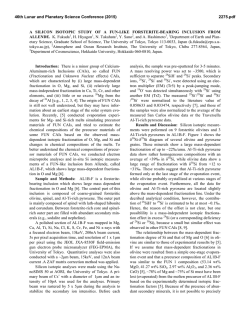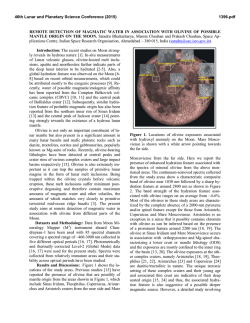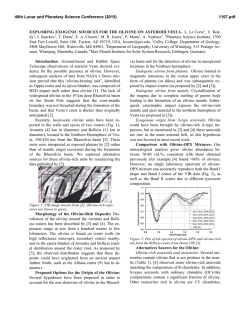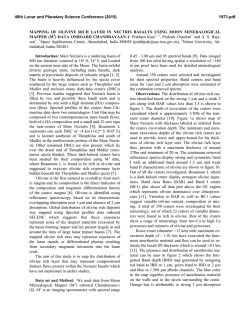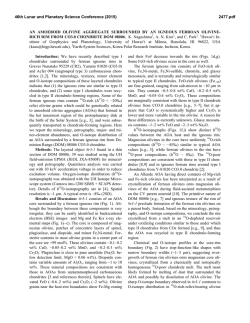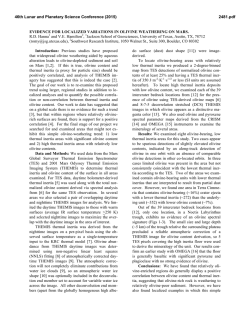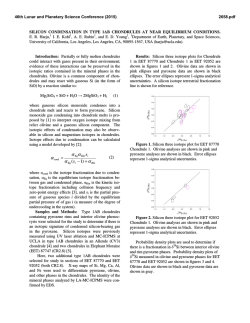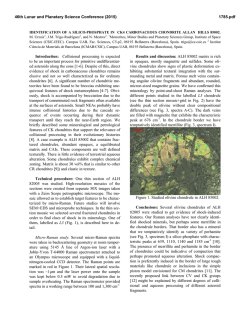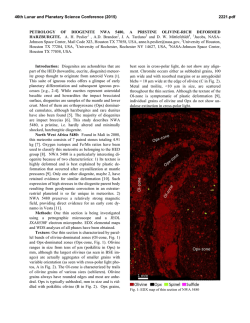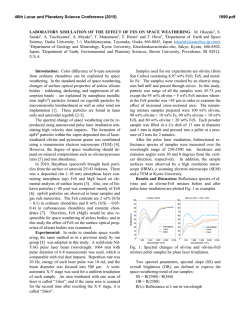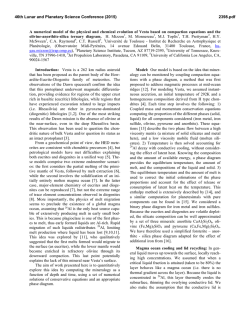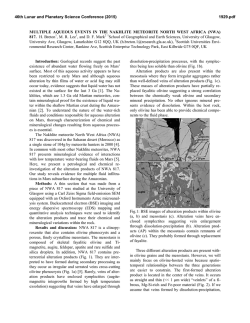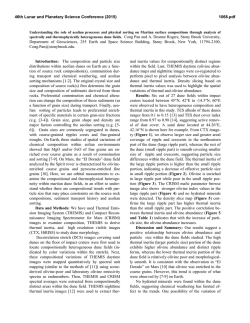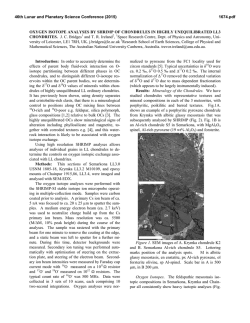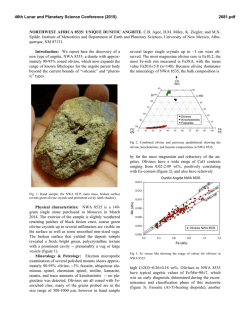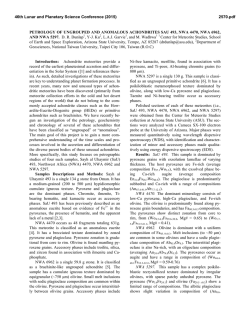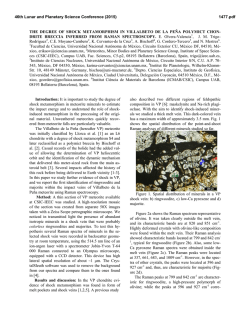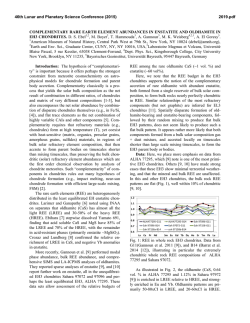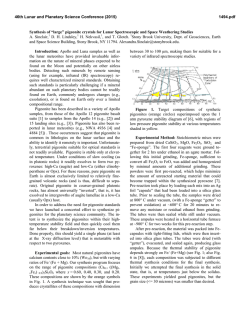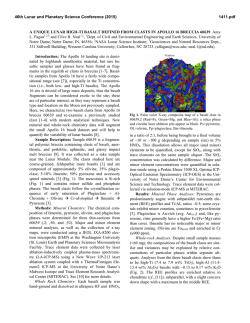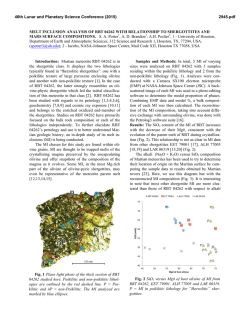
1267
46th Lunar and Planetary Science Conference (2015) 1267.pdf IGNEOUS PETROLOGY AND GEOCHEMISTRY OF THE TISSINT METEORITE. J.B. Balta1-2, M.E. Sanborn3-4, A. Udry1-5, M. Wadhwa3 and H.Y. McSween2. 1Planetary Geoscience Institute, University of Tennessee, Knoxville TN. 2University of Pittsburgh, Pittsburgh PA, [email protected]. 3Arizona State University, Tempe AZ. 4UC Davis, Davis CA. 5UNLV, Las Vegas, NV. Introduction: Since its fall and recovery in the Moroccan desert during 2011, the Tissint meteorite has been the subject of a number of studies, including studies of its shock phases, melt inclusions, and hydrogen isotopes [1-4]. However, there has yet to be a complete summary of the the Tissint meteorite’s origin from a perspective of its igneous petrogenesis. Tissint is an olivine-phyric shergottite, the class of meteorites with parent melt compositions closest to equilibrium with the martian mantle, and thus understanding its igneous petrogenesis will give new geochemical constraints about the martian mantle and generation of shergottite magmas. To characterize this igneous petrogenesis and place Tissint in the context of the other shergottites, we conducted a detailed analysis of two thin sections of the Tissint meteorite obtained from Arizona State University’s Center for Meteorite Studies collection. We characterized the sample through petrography, backscattered electron imaging, and Electron Microprobe analyses at the University of Tennessee, and secondary ion mass spectrometry at Arizona State University. We find that Tissint occupies a unique petrologic niche in the shergottites, distinct chemically from the other martian meteorites. These distinctive properties include both its highest-Mg # olivine falling in a previously-unsampled range, the largest range in olivine compositions observed in a shergottite, and a unique crystalization path with olivine on the liquidus before chromite. It shows a highly-reduced oxygen fugacity consistent with other depleted shergottites, but its trace element abundances overlap those observed in more oxidized or intermediate shergottites. It may represent a more olivine-rich and thus closer-to-primary version of basaltic shergottite QUE 94201. Olivine: Olivine in Tissint varies from Mg# 81 to 29, including the most Fe-rich rims found in any olivinephyric shergottite. Olivine cores are close to homogeneous between Mg # 80-81; large olivines contain melt inclusion trails implying they are glomerocrysts and likely resided inside an active magmatic system before entrainment. The two examined sections contained 27% and 24% olivine respectively and have accumulated 7-10% olivine beyond what could form from the Tissint parental magma, a number similar to that observed in several olivine-phyric shergottites [5]. Crystal Size Distribution (CSD) measurements show negatively-sloped arc shapes, consistent with overabun- dance of largest crystals compared to what simple crystallization would produce [6] as would occur with assembly of glomerocyrsts. Olivine REE abundances are low, below detection limits in many cases, with no sign of upturn in the LREE pattern associated with alteration or hot-desert weathering [7]. Pyroxenes: Pyroxenes make up 50-52% of the two thin sections, similar to the abundance in other olivinephyric shergottites. Pyroxene compositions also overlap those in other olivine-phyric shergottites, continuously varying between pigeonite and augite with Ferich overgrowths. Minor elements, including Ti and Al, vary significantly and are correlated with geochemical properties such as Mg # that suggest coupling to the crystallization sequence. Minor elements in pyroxene also overlap with those observed in other previous shergottites including depleted shergottite QUE 94201 and intermediate shergottite EETA 79001A [8-9]. Pyroxene trace element abundances increase from pigeonite/Mg-rich cores to augite/Fe-rich rims and show small Eu anomalies that increase slightly from pigeonite to augite. No upturn in the LREE pattern is observed in Tissint pyroxenes. Maskelynite: All plagioclase in Tissint has been converted to maskelynite during shock. Maskelynite made up 20-22% of the analyzed thin sections. Maskelynite varies from An68Ab42Or1 to An47Ab48Or5, comparable to shergottites such as QUE 94201 and EETA 79001A in their An-rich end member but with a slightly more Ab-rich end-member [9-10]. Maskelynites are REEdepleted relative to other shergottites including some depleted shergottites, but are overall similar to DaG 476/489 [11]. Eu anomalies in Maskelynite are smaller than those observed in depleted shergottites including DaG 476/489 or in intermediate shergottite EETA 79001A, but are larger than those observed in enriched shergottite LAR 06319 [12]. Minor phases: Merrillite is the dominant phosphate in Tissint; our investigations did not locate any apatite in these two thin sections although it has been previously reported [13]. Merrillites range from 2.4 to 4.9 wt. % FeO, making them among the more Fe-rich phosphates observed in shergottites. This phase is the main REE carrier in Tissint. Merrillite REE abundances parallel those of other depleted and intermediate shergottites but average REE contents are slightly elevated even 46th Lunar and Planetary Science Conference (2015) relative to intermediate shergottite EETA 79001A [8]. No upturn in the LREE pattern is observed in Tissint merrillites. Oxide minerals vary in composition from chromite through titanomagnetite to magnetite and ulvöspinel, with the latter having cocrystallized with ilmenite. A full compositional trend from Cr-rich to TiFe rich oxides is present in Tissint. Notably, no coarsegrained chromites were observed as inclusions in olivine phenocrysts unless also accompanied by a meltpocket. Sulfides are present and are uniformly pyrrhotite, as found in other shergottites. Implications for Magma Evolution: Olivine was the first mineral to crystallize from the Tissint parent magma. Olivine as the liquidus mineral implies crystallization began at pressures below the multiplesaturation point for olivine and pyroxene; e.g., below ~1.2 GPa [14]. Tissint is the 3rd olivine-phyric shergottite to contain olivines with Mg # > 80; Yamato 980459 and NWA 5789 contain olivines with Mg # ~ 85 [15-16] and thus the most Mg-rich olivines from Tissint fall into a previously unsampled range. The CSD pattern of Tissint olivines resembles that of enriched shergottite LAR 06319 [12], implying that olivine crystallization followed by storage in an active magmatic system is likely a common process in shergottite magmatism across both the enriched and depleted end-members. Chromite crystallization in Tissint was delayed until after significant olivine crystallization, a result not previously described in shergottites. Olivine grains were held together, either in a cumulate pile or on the edges of a magma chamber, where multiple grains fused together into glomerocrysts and olivine compositions homogenized. After re-entrainment of these olivines into the final host magma, chromite, lower-Mg # olivine, and orthopyroxene/pigeonite began co-crystallizing, with plagioclaise crystallization beginning shortly thereafter. Pyroxene minor elements suggest depletion of Ti and Al in the melt during crystallization and possibly decreasing pressure [17], although there is no evidence of dissolution of olivine or pyroxene as might be expected during decompression [18]. Tissint shows evidence of an extended crystallization interval, producing ironrich rims on olivines and Fe-Ti rich oxide phases. Measured trace element abundances in pyroxenes and merrillites were used along with known REE partition coefficients to reconstruct the REE abundances in the Tissint parent magma and its subsequent evolution. The calculated melt in equilibrium with the pigeonite cores is within error of, and parallel to, the measured whole rock composition (our measured bulk rock REE composition agrees with previously- 1267.pdf presented measurements of Tissint [13]). These calculations also show that both early-crystallized pyroxenes and late-crystallized merrillites could be formed from a single parental magma, implying no assimilation of any enriched component during crystallization. No upturn in the LREE pattern is observed in pyroxenes although this was previously reported in Tissint melt inclusions [4], implying a post-trapping origin the LREE pattern in those inclusions. The REE abundances in the Tissint bulk rock generally overlap with those of shergottites classified as intermediate based on isotopic compositions and oxygen fugacities, reinforcing previous suggestions of similarities between REE abundances of these two groups [19]. Tissint’s bulk rock REE pattern also parallel that of depleted basaltic shergottite QUE 94201, but with higher REE abundances in QUE 94201 consistent with its lack of olivine [8]. Oxygen fugacities calculated using the olivinepyroxene-spinel assemblage give values in the range QFM -3.5 to -4.0 depending on choice of mineral composition [20]. Application of the Eu oxybarometer to pyroxene cores [21] gives fO2 of QFM -2.4, slightly more oxidized than suggested by the mineral assemblages but within the 2SD error of the calibrations. Tissint is therefore among the most reduced of the shergottite meteorites, comparable to other depleted shergottites such as SaU 005 [22] and QUE 94201, and could represent a more olivine-rich, parental version of basaltic shergottite QUE 94201. References: [1] Baziotis I.P et al. (2013) Nature, 4, 1404-1408 [2] Brennecka G.A. et al. (2014) MAPS 49(3), 412-418 [3] Mane P. et al. (2013), LPSC XLIV, #2220 [4] Peters T.J. et al. (2014), LPSC XLV, #2405 [5] Filiberto J. and Dasgupta R. (2011) EPSL 304, 527537 [6] Udry A. et al. (2013), LPSC XLIV, #1719. [7] Crozaz G. and Wadhwa M. (2001), GCA 67, 47274741. [8] Wadhwa M. et al. (1994), GCA 58, (42134229) [9] Wadhwa M. et al. (1998), MAPS 33, 321328. [10] McSween H.Y. and Jarosewich E. (1983), GCA 47, 1501-1513. [11] Wadhwa M. et al. (2001), MAPS 36, 195-208. [12] Balta J.B. et al. (2013), MAPS 48, 1359-1382. [13] Chennaoui Aoudjehane, H. et al. (2012) Science 338, 785-788 [14] Balta J.B. and McSween H.Y. (2013), JGR Planets 2013JE004461 [15] Ikeda Y. (2004), Ant. Met. Res. 17 (35-54). [16] Gross J. et al. (2013), MAPS 46, 116-133 [17] Filiberto J. et al. (2010), MAPS 45, 1258-1270. [18] Liu Y. et al. (2013) GCA 108, 1-20. [19] Symes S.J.K. et al. (2008), GCA 72, 1696-1710. [20] Sack R. and Ghiorso M. (1994), Contrib. Min. Pet. 118, 277-306. [21] WadhwaM. (2001), Science 291, 1527-1530. [22] Herd C.D.K. (2003), MAPS 38, 1793-1805.
© Copyright 2025
